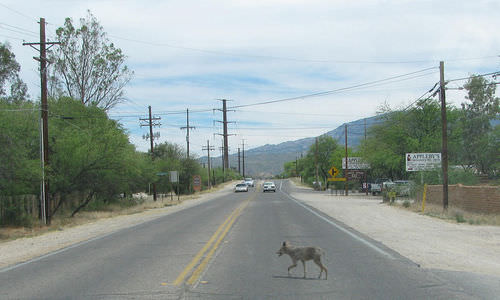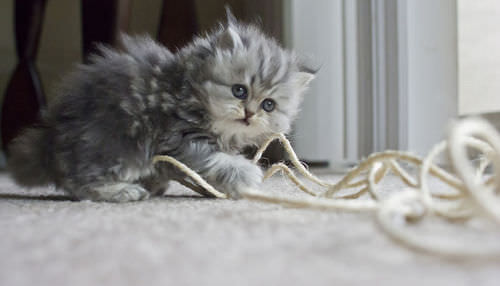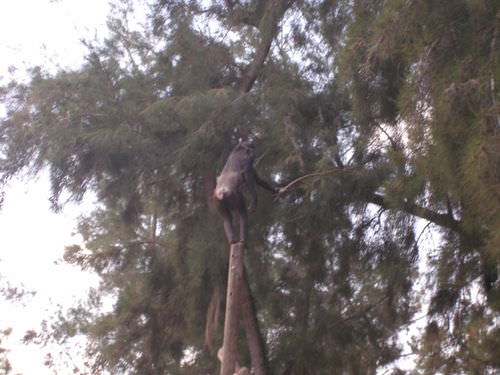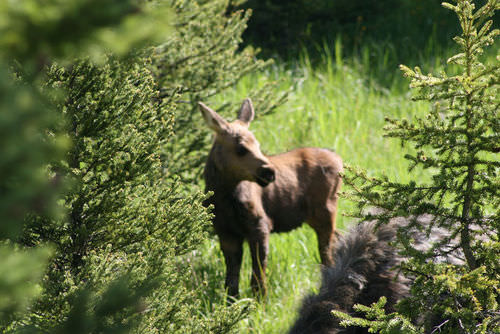14.7 动物的行为 -- -- 高级
章节大纲
-
How do these baby know what to do?
::这些孩子怎么知道该做什么?Some infant are really good at playing the game "Follow the Leader." Some baby animals instinctively follow and become attached to whatever large moving object they first see. The moving object is usually their mother. This is an instinctive behavior that results in imprinting. Becoming imprinted on the mother helps ensure their survival.
::一些婴儿非常擅长玩游戏“跟随领队 ” 。 一些幼崽动物本能地跟随并依附于他们首先看到的任何大型移动物体。 移动对象通常是他们的母亲。 这是一个本能的行为,导致印记。 成为母亲的印记有助于确保她们的生存。Learned Behavior
::学习行为Learning is a change in behavior that occurs as a result of experience. Compared with , learned behaviors are less rigid. Many learned behaviors can be modified to suit changing conditions. For example, drivers may have to change how they drive (a learned behavior) when roads are wet or icy, otherwise they may risk losing control of their vehicle. Because learned behaviors can be modified when the environment changes, they are generally more adaptive than innate behaviors. that are more intelligent typically have a greater proportion of behaviors that are learned rather than innate.
::学习是因经验而产生的行为变化。 与学习行为相比, 学习行为不那么僵硬。 许多学习行为可以修改以适应不断变化的条件。 比如, 司机可能不得不改变道路湿润或冰冷时的驾驶方式( 学习行为 ) , 否则他们可能失去对车辆的控制。 因为学习行为在环境变化时可以改变,它们通常比天生行为更具适应性。 更聪明的行为通常比天生行为更具有学习而不是内在的行为比例。Types of Learning
::学习类型Animals may learn behaviors in a variety of ways. Some ways in which animals learn are relatively simple. Others are very complex. Types of learning include the following:
::动物可以以多种方式学习行为。 动物学习的方式比较简单。 另一些则非常复杂。 学习类型包括:-
Habituation
.
::伤风败俗 -
Sensitization.
::宣传。 -
Classical
conditioning
.
::古老的修饰 -
Operant conditioning.
::运行调节。 -
Observational learning.
::观察学习。 -
Play.
::玩吧 玩吧 玩吧 玩吧 玩吧 -
Insight learning
.
::透视学习。
Habituation and Sensitization
::伤情和提高认识One of the simplest ways that animals learn is through habituation. In this type of learning, animals decrease the frequency of a behavior in response to a repeated stimulus . This occurs when the behavior does not result in some type of benefit or reward. Habituation has been demonstrated to occur in virtually every species of animal. It is adaptive because responding to a stimulus when there is no benefit or reward is a waste of energy .
::动物最简单的学习方式之一是习惯。 在这种学习中,动物会减少行为频率,以应对反复的刺激。当行为没有带来某种利益或奖励时,就会发生这种情况。几乎所有动物物种都表现出了受虐行为。这是适应性的,因为在没有好处或奖励时对刺激作出反应就是浪费能量。An example of habituation is the behavior of certain species of small songbirds when presented with a stuffed owl or similar “ predator .” If a stuffed owl is placed in their cage, the birds first respond as though it were a real predator. They act frightened and try to escape. Over time, as the stuffed owl remains in the cage without moving, the birds show less response. They become habituated to the presence of the stuffed owl. A similar example of habituation is when coyotes invade human neighborhoods. They have become habituated to humans in these locations, so they are no longer afraid to approach (shown in Figure ).
::习惯化的一个例子是某些小鸟的行踪,这些小鸟在被塞猫头鹰或类似的“捕食者 ” 。 如果把一个塞猫头鹰放在笼子里,鸟儿首先的反应就好像它是一个真正的掠食者。它们采取惊吓行动并试图逃跑。随着时间推移,随着猫头鹰不动地留在笼子里,鸟儿的反应就会减少。它们变得习惯于被塞猫头鹰的存在。一个类似的习惯化的例子就是土狼入侵人类社区。它们已经习惯于这些地方的人类,因此它们不再害怕接近(图中显示 ) 。Coyotes are becoming increasingly habituated to humans, especially when humans feed them, so they are no longer afraid to approach human neighborhoods. This can be quite dangerous, as coyotes are known to attack livestock, pets, and, sometimes, even humans.
::土狼越来越习惯于人类,特别是当人类喂养它们时,他们不再害怕接近人类的邻里。 这可能非常危险,因为土狼会攻击牲畜、宠物,有时甚至人类。Sensitization is the opposite of habituation. In sensitization, an animal learns to react more often or more strongly to a repeated stimulus. For example, exposure to painfully loud sounds causes an animal to respond strongly. The animal may act agitated and try to escape from the source of the sounds. If the loud sounds are followed by lesser sounds that are not painful, the animal may respond to them just as strongly. If this occurs, the animal has become sensitized to sounds.
::感知与习惯相反。 在感知中, 动物学会了对反复刺激做出更频繁或更强烈的反应。 例如, 接触痛苦的响声会让动物做出强烈的反应。 动物可能会采取激动行动, 试图逃离声音的来源。 如果响声后的声音不痛苦, 动物也会同样强烈地响应它们。 如果发生这种情况, 动物就会对声音有敏感认识 。Scientists have demonstrated that sensitization occurs because of changes in nerve and nerve pathways (see The and The concepts). These changes take place after nerves have been stimulated repeatedly. This sometimes occurs in a person who has had a painful injury. With repeated stimulation of the nerves, sensitization occurs, and the pain continues even after the injury is healed.
::科学家们已经证明,神经和神经路径的变化(见“The”和“概念”)导致敏感化,这些变化是在神经被反复刺激后发生的,有时是在受了痛苦伤害的人身上发生的。 在神经的反复刺激下,敏感化会发生,甚至在受伤愈合后疼痛也会持续。Classical Conditioning
::古典条件Classical conditioning is a type of learning in which an animal learns to associate one stimulus with another. In this type of learning, a stimulus that normally produces a particular behavior is linked with a second stimulus. The second stimulus is something neutral to which the animal does not normally respond. If the animal is repeatedly exposed to both stimuli together, it learns to associate the two stimuli. Because of this association, the animal will respond to the second stimulus alone in the same way that it responds to the normal stimulus.
::古典条件是一种学习类型,动物学习将一种刺激与另一种刺激联系起来。在这种学习类型中,通常产生一种特定行为的刺激与第二种刺激相联系。第二种刺激是动物通常不会反应的中性因素。如果动物反复接触两种刺激,它就会学会将两种刺激联系起来。由于这种联系,动物将单独对第二种刺激作出反应,就像它对正常刺激的反应一样。A well-known example of classical conditioning is the work of the Russian scientist Ivan Pavlov. In the late 1800s and early 1900s, Pavlov investigated behavior in dogs. As mentioned above, dogs instinctively drool when they see or smell food . They also drool when they think that they are about to be fed. Pavlov conditioned dogs to drool when they heard a particular sound, such as a bell or whistle. He made the sound just before he fed the dogs, and the dogs learned to associate the sound with food. In a short time, they started drooling as soon as they heard the sound. Because of Pavlov’s research in this area, classical conditioning is sometimes called Pavlovian conditioning.
::俄罗斯科学家伊万·帕夫洛夫(Ivan Pavlov)的工作就是古典调节的著名例子。 在1800年代末和1900年代初,帕夫洛夫调查了狗的行为。如上所述,狗在看到或闻到食物时会本能流口水。当他们认为自己即将被喂食时,狗也会流口水。帕夫洛夫让狗在听到某种声音(如铃声或哨声)时会流口水。他在喂狗之前就发出声音,狗会学会把声音与食物联系起来。不久,他们一听到声音就立刻开始流口水。 由于帕夫洛夫在这一领域的研究,古典调有时被称为“帕夫洛夫调制 ” 。Another example of classical conditioning is called conditioned taste aversion. Animals may learn not to eat certain foods if they have ever become ill after eating them. This is an adaptive trait because it may help them avoid foods that are poisonous. For example, animals that vomit after eating a particular type of berry may learn to avoid eating berries of this type in the future. They become conditioned to avoid the berries because they have learned to associate the berries with vomiting.
::另一种古典疗法的例子被称为有条件的厌恶品味。 动物如果在吃过之后生病,可以学会不吃某些食物。 这是一种适应性特征,因为它可以帮助他们避免有毒食物。 比如,吃过一种特定种类的白莓后呕吐的动物可以学会避免将来吃这种果子。 它们会习惯于避免吃果子,因为他们学会了把浆果与呕吐联系起来。Operant Conditioning
::运行条件In operant conditioning, an animal learns either to perform a behavior that is rewarded or to stop performing a behavior that is punished. One of the first scientists to investigate this type of learning was Edward Thorndike. In the early 1900s, Thorndike investigated learning in cats. He placed the cats in “puzzle boxes” that he had constructed. It was difficult for the cats to find their way out of the mazelike boxes, but they kept trying because they did not like being confined. When first placed in one of the boxes, a cat needed a long time to find the way out. However, the cat needed less and less time with repeated trials. Through trial and error, the cat learned how to escape from the box.
::在操作调节中,动物学会要么执行奖励行为,要么停止进行惩罚行为。调查这类学习的第一批科学家之一是爱德华·桑迪克。在1900年代初,桑迪克调查猫的学习情况。他把猫放进了他建造的“喷雾箱 ” 。猫很难从迷宫般的盒子中找到出路,但因为不喜欢被禁闭,所以他们一直在努力。第一次把猫放进盒子里时,猫需要很长时间才能找到出路。然而,猫需要越来越少的时间进行反复试验。通过试验和错误,猫学会了如何逃离盒子。Beginning in the 1930s, another scientist, named B.F. Skinner, did similar research with rats. He placed rats in a box containing a bar. If the rats stepped on the bar, a pellet of food was released. When first placed in the box, a rat did not know that stepping on the bar would release a food pellet. Sooner or later, the rat would accidentally step on the bar and be rewarded with food. Before long, the rat learned that a food pellet would be released each time it stepped on the bar. After that, it stepped on the bar repeatedly in order to get the food.
::从1930年代开始,另一位名叫B.F.Skinner的科学家对老鼠进行了类似的研究。他把老鼠放在一个装有棍子的盒子里。如果老鼠踩上酒吧,就会释放出一粒食物。当老鼠第一次被放在盒子里时,老鼠并不知道踩上酒吧会释放出一个食物桶。老鼠迟早会无意地踩上酒吧,并获得食物奖励。不久,老鼠就发现每次踩上酒吧时都会释放出一个食物桶。之后,它又一再踩上酒吧,以获取食物。In operant conditioning, the reward may be something positive that is gained (food in the case of Skinner’s rats) or something negative that is avoided (confinement in the case of Thorndike’s cats). In either case, a behavior is learned through trial and error because it is reinforced by a reward. Operant conditioning can also use punishment to discourage a behavior. A punishment is something unpleasant or painful. An example of this occurs when cows are placed in a pasture surrounded by an electrified fence. The fence alone is inadequate to keep them in the pasture. It is just a single strand of wire strung between posts that are several feet apart. However, when the cows touch the fence, they receive an electric shock. They soon learn from the punishment (the shock) to stay away from the fence (the behavior).
::在操作调节中,奖赏可能是得到的正面的(在Skinner的老鼠身上是食物),也可能是避免的负面的(在Thorndike的猫身上是封闭的 ) 。 在这两种情况下,行为都是通过试验和错误来学习的,因为它有奖赏。 机能调节也可以用惩罚来劝阻行为。惩罚是令人不快或痛苦的。当牛被用电动的栅栏包围在牧场上的时候,就出现了这种惩罚的事例。只有栅栏不足以将牛留在草场上,只是几英尺不同的柱子之间一根线。然而,当牛碰到栅栏的时候,它们就会受到电击。它们很快会从惩罚中学到远离栅栏(行为 ) 。Can you think of a behavior that you learned from operant conditioning? Maybe you learned that taking notes in class results in better grades on exams. Getting better grades (the reward) may have reinforced note taking (the behavior). You probably also learned to avoid behaviors that were punished. For example, when you were younger, fighting with a sibling may have resulted in a time-out. After repeated time-outs (the punishment), you may have learned to avoid fighting with your sibling (the behavior). Did you ever touch your tongue to a metal object on a cold winter day? If you did, then you know that your tongue “sticks” to the metal and that pulling your tongue away from the metal is very painful. If you learned to avoid this behavior because of the pain, then this is also an example of operant conditioning.
::你能想到你从手术中学到的行为吗?也许你学到了在课堂上记笔会提高考试成绩。获得更好的成绩(奖励)可能强化了记分(行为 ) 。你也许还学会了避免受惩罚的行为。例如,在你年轻的时候,与兄弟姐妹打架可能导致暂停。在反复停课(惩罚)之后,你也许学会了避免与兄弟打架(行为 ) 。你有没有在寒冷的冬天用舌头触碰过金属物体?如果你这样做,你就会知道,你的舌头对金属的“棍子”和把舌头从金属上拉走是非常痛苦的。如果你学会避免这种痛苦,那也是个变形的例子。Observational Learning
::观察学习Perhaps you learned to avoid touching your tongue to a freezing metal object because you saw another child do it and realized how painful it was from the other child’s reaction. If so, then you learned not to do it yourself through observational learning. This type of learning involves observing the behavior of another individual and either copying the behavior or avoiding it. Most studies of observational learning have focused on behaviors that are copied. Canadian psychologist Albert Bandura is world renowned for his investigations of observational learning in humans. According to Bandura, learning a behavior by observing it in someone else requires four conditions to be met:
::或许你学会了避免用舌头触摸冷冻的金属物体,因为你看到另一个孩子这样做,并意识到它从另一个孩子的反应中是多么的痛苦。如果是这样,那么你就会通过观察学习学会不要自己这样做。这种学习涉及观察另一个人的行为,或者复制行为,或者回避行为。 大多数观察学习研究都集中在复制的行为上。加拿大心理学家Albert Bandura因调查人类观察学习而闻名于世。根据班杜拉的说法,通过观察别人的行为学习需要满足四个条件:-
An individual (the observer) must pay attention to the behavior of another individual (the model).
::个人(观察员)必须注意另一个人的行为(模式)。 -
The observer must be able to remember what the
model
has done.
::观察员必须能够记住模型所做的一切。 -
The observer must have the ability or skills to perform the behavior.
::观察者必须具备行为能力或技能。 -
The observer must be motivated and have the opportunity to perform the behavior.
::观察者必须具有积极性,并有机会进行这种行为。
Because of these conditions, observational learning requires considerable intelligence and is found most often in humans. However, observational learning has also been observed in many other species of animal. For example, wolves and other predatory animals that hunt in packs learn hunting skills through observational learning. Young animals observe and copy the behavior of older animals when they hunt together.
::由于这些条件,观察学习需要相当多的智慧,而且往往在人类中发现。然而,在其他许多动物物种中也观测到观察学习。例如,狼和其他在群中狩猎的掠食动物通过观察学习学习狩猎技能。年轻的动物观察和复制老年动物一起狩猎时的行为。Another example of observational learning involves Japanese macaques (a species of monkey shown in Figure ). In the 1960s, a group of researchers started placing sweet potatoes on a sandy beach to lure macaques out of a nearby forest. Soon the macaques started coming out on the beach to eat the sweet potatoes. At first, the macaques just brushed the sand off the sweet potatoes before eating them. Then, about a year later, a female macaque was observed washing sweet potatoes in the ocean before eating them. Her behavior was observed and copied by other macaques in the troop. Before long, all the macaques in the troop were washing their sweet potatoes in the ocean. When these monkeys gave birth, their offspring also learned this behavior by observing and copying the behavior of their parents and other adults.
::另一个观察学习的例子涉及日本的鹦鹉(如图所示的猴子种类)。1960年代,一群研究人员开始在沙滩上放甘薯,把马铃薯从附近的森林中诱出。不久,马铃薯就开始到海滩上吃甜土豆。起初,马铃薯在吃之前刚从甜土豆上刷出沙子。大约一年后,观察到一只雌马铃薯在吃之前在海洋中清洗甜土豆。部队中其他的马铃薯观察和复制了她的行为。不久,部队中的所有马铃薯都在海洋中清洗他们的甜土豆。这些猴子出生后,他们的后代也通过观察和模仿父母和其他成年人的行为来学习这种行为。Japanese macaques have learned to wash sweet potatoes in the ocean before eating them. This behavior was first noted in one macaque. Other macaques in the troop soon learned the behavior through observational learning.
::日本的红豆在吃之前学会了在海洋中洗甘薯。第一次在一只红薯中发现了这种行为。部队中的其他大猩猩很快通过观察学习学到了这种行为。Many human behaviors are learned by children through observation and mimicking the behaviors of the people around them. What behaviors have you learned in this way? For example, as a young child, did you learn how to tie your shoes by watching your parents or older siblings tie their shoes? Did you learn how to solve a math problem by watching your teacher solve one like it? Did you learn how to play a video game by observing a friend play the game? If so, you were learning the behaviors through observational learning.
::儿童通过观察和模仿周围人的行为来学习许多人类行为。 你通过这种方式学到了哪些行为?例如,作为一个幼儿,你是否学会了如何通过看着父母或年长的兄弟姐妹穿鞋来系鞋?你是否学会了如何通过看着老师解决这样的数学问题来解决数学问题?你是否学会了如何通过观察朋友玩游戏来玩电子游戏?如果是这样,你就是通过观察学习来学习这些行为。Play
::播放播放Playing a video game is just one of the many ways in which humans may play. Play involves behaviors that have no particular goal except enjoyment or satisfaction. Play is not restricted to humans. Most mammals and many birds also play when they are young. The drive to play seems to be innate in many species. You have probably seen kittens, like the one in Figure , playing with a toy. Play may also involve other animals. For example, kittens often play with their littermates. Like other predatory animals — including lions and some species of bears — kittens chase, pounce on, and wrestle with one another. Prey animals such as deer and zebras play somewhat differently. They run, leap, and kick their hind legs when they play.
::玩游戏只是人类可以玩的多种方式之一。游戏涉及除了享受或满足之外没有特定目标的行为。游戏并不局限于人类。 多数哺乳动物和许多鸟类在年轻时也玩耍。 玩耍的动力似乎在很多物种中是天生的。 你可能见过小猫,如图中的小猫,玩玩玩具。 玩耍还可能涉及其他动物。 比如, 小猫经常玩玩他们的玩偶。 就像其他掠食动物一样, 包括狮子和某些种类的熊 — — 小猫追逐、扑击和相互搏斗。 像鹿和斑马一样的猎物玩耍, 它们跑,跳,在玩耍时踢尾腿。Kittens often play with toys.
::Kittens经常玩玩具。This adult cat is trying to catch a mouse.
::这只成年猫想抓一只老鼠Play is one way that young animals develop the skills needed during . How does playing with a toy prepare this kitten for catching mice as an adult?
::玩耍是年轻动物发展所需技能的一种方式。玩玩具如何让小猫成年时捕捉小鼠?Play has risks and costs. It may increase exposure to predators and lead to injury. It also requires energy. For play to have evolved, it is likely to have significant benefits that outweigh these drawbacks. How could play be beneficial? Play is actually a form of learning. Through play, young animals learn important skills. By chasing, pouncing on, and wrestling with one another, kittens and other young predators are learning how to catch prey (see the adult cat in Figure ). By running, leaping, and kicking their hind legs, young deer, zebras, and other prey animals are learning how to escape or ward off attacks from predators. Play can also be beneficial by helping young animals develop and improve their physical fitness .
::游戏具有风险和成本。 它可能会增加与掠食动物的接触并导致伤害。 它还需要能量。 玩耍要进化起来, 它可能具有比这些缺点更大的好处。 玩耍实际上是一种学习形式。 玩耍是游戏, 年轻的动物通过玩耍学习重要的技能。 通过追逐、 击打和相互摔跤, 小猫和其他年轻的捕食动物正在学习如何捕食猎(见图中的成年猫 ) 。 通过跑步、跳跃和踢它们的后腿, 小鹿、斑马和其他猎物正在学习如何逃脱或抵御捕食动物的攻击。 玩耍也可以通过帮助幼动物发展和改善其身体健康而受益。Insight Learning
::洞见学习Several species of animals have been observed using insight learning. Insight learning is the use of past experiences and reasoning to solve problems. Unlike operant conditioning, insight learning does not involve trial and error. Instead, an animal thinks through a solution to a problem based on previous experience. The solution often comes in a flash of insight. Insight learning requires relatively great intelligence. Species most likely to learn in this way include species of apes (chimpanzees, gorillas, and orangutans), crows, and humans.
::利用洞察力的学习观察了几种动物。 洞察力的学习是利用过去的经验和推理来解决问题。 与机能调节不同, 洞察力的学习并不涉及试验和错误。 相反, 动物根据以前的经验来思考解决问题的办法。 洞察力的学习往往需要相当高的智慧。 以这种方式学习的物种最有可能包括猿类(猩猩、大猩猩和猩猩)、乌鸦和人类。Examples of insight learning in apes in the wild include chimpanzees "fishing" for termites. The animals place a “tool” such as a twig in a hole of termite mound, and the termites crawl onto the twig. Then the chimpanzee withdraws the twig from the hole and eats the termites. Chimpanzees may also use leaves to sop up drinking and rocks to smash nuts. They have even been observed sharpening sticks with their teeth and using them as spears to kill small animals for food. Another example of tool use in chimpanzees in the wild is shown in Figure . Gorillas may use tools to solve problems as well. For example, they have been observed using small branches as walking sticks and as measuring sticks to test the depth of water before wading through it. Orangutans use small sticks to get at edible seeds inside prickly fruits without being pricked. They may also use leaves to make rain-hats and roofs over their sleeping nests.
::野生猿的洞见性学习实例包括黑猩猩“捕捉”白蚁。动物们把“工具”放在白蚁丘洞里,如树枝,白蚁爬到树枝上。然后黑猩猩把树枝从洞里取出来,吃掉白蚁。黑猩猩还可能用叶子来煮酒和石头来砸碎坚果。他们甚至看到用牙尖来磨棍,用它们作为矛头来杀死小动物作为食物。在野生黑猩猩使用工具的另一个例子见于图中。大猩猩可能用工具解决问题,例如,用小树枝作为拐杖和测量棍子来测试水的深度,然后通过它行走。奥兰古人用小棍子在刺利的水果中获取可食用种子,而不用刺刺。他们也可以用叶子在睡巢上撒雨水和屋顶。This chimpanzee is using a stick as a tool to obtain food that is out of reach. This is an example of insight learning.
::这个黑猩猩正在用棍子作为获取无法获取的食物的工具。这是洞察力学习的一个例子。Crows and related species of birds have large brains relative to their body size and are noted for their intelligence. They also use insight learning to solve problems. For example, a crow was observed placing nuts on the crosswalk of a busy street, where cars would drive over them and crack the shells. After the traffic light turned red, the crow entered the street to retrieve the nutmeats. Crows have also been seen working together to eat food scraps in a trashcan. Some of the crows propped up the lid of the can, while the others ate the scraps inside. Then the crows switched places so that all of them had a chance to eat.
::乌鸦和相关鸟类种类的大脑与其身体大小相比大,并被记录在他们的智慧之下。它们还利用洞察力学习解决问题。例如,观察到乌鸦在繁忙街道的十字路口放置坚果,在那里,汽车会开车穿过它们并打破贝壳。在交通灯变红后,乌鸦进入街道取回坚果。还看到乌鸦一起在垃圾桶里吃零食。有些乌鸦把罐子盖起来,而另一些乌鸦则吃了里面的碎屑。然后乌鸦换了位置,让它们都有机会吃。Homo sapiens have larger brains (for their body size) and are more intelligent than any other species. Humans are also known for their incredible ability to use insight learning to solve problems, ranging from learning how to start a fire to putting a man on the moon. Think about problems you have solved in the past. Perhaps you learned how to use a new computer program through reasoning and past experience with other computer programs. You may also have used reasoning and previous experience to solve math problems or attain the next level of a video game.
::智人有更大的大脑(身体大小),比其他任何物种都更聪明。人类也以其利用洞察力学习解决问题的惊人能力而著称,从学会如何点火到将人送上月球。想想你过去已经解决的问题。也许你通过推理和其他计算机程序的经验学会了如何使用新的计算机程序。你可能还利用了推理和以往的经验来解决数学问题或达到下一个电子游戏的水平。Behavior Influenced by Both Genes and Learning
::受基因和学习影响的行为The ability to learn behaviors in all these different ways depends on intelligence, which is at least partly determined by genes . However, the environment also plays a role in learned behaviors. For example, classical conditioning depends on the presence of a suitable reward or punishment, and observational learning depends on the behavior of potential models.
::以所有这些不同方式学习行为的能力取决于智力,而智力至少部分是由基因决定的。 但是,环境在学习行为中也起着一定的作用。 比如,古典条件取决于是否有合适的奖赏或惩罚,观察学习取决于潜在模型的行为。A type of behavior that clearly shows the influence of both genes and environment is imprinting. Like instinct , imprinting results in fixed, lifelong behaviors after exposure to a stimulus. Also like instinct, imprinting leads to full-blown behaviors after the first exposure to the stimulus. However, the environment also plays a role in imprinting. The animal must be exposed to the proper stimulus during a period of called the critical period. This period is commonly a few days or weeks in early life. In addition, the type of stimulus that triggers an imprinted behavior determines how the behavior is performed. Therefore, imprinting depends on both instinct and learning and may vary with the environment.
::一种明确显示基因和环境影响的行为正在刻画。 和本能一样, 在受到刺激后固定的、终身的行为中印出结果。 与本能一样, 印印印结果在固定的、 终身的行为中。 与本能一样, 印印结果导致在第一次受到刺激后的全面行为。 但是, 环境也在印出过程中起到一定作用 。 动物必须在一个被称为关键时期的时期接触适当的刺激。 这个时期通常是早期生命中的几天或几周。 此外, 触发印出的行为的刺激类型决定了行为是如何实施的。 因此, 印印结果取决于本能和学习, 并可能与环境不同 。Imprinting often occurs in species in which the young are fairly mobile early in life. Animals in which imprinting occurs include species of birds and herbivorous mammals. In these species, baby animals instinctively follow and become attached to whatever large moving object they first see during the critical period. The moving object is usually their mother. Becoming imprinted on the mother helps ensure their survival. They are unlikely to wander off after they have become imprinted on her. However, the infants may become imprinted on any other large moving object if they see it first during the critical period. This could be a balloon blowing across the ground or a human walking nearby. Once attachment to the object occurs through imprinting, the behavior is fixed and cannot be changed. The animal remains attached to the object for life. Moose calves ( Figure ) also imprint on their mothers. If a moose calf were to imprint on a human, it would continue its attachment to humans rather than members of its own species. As an adult, the moose would be likely to try to attract humans, rather than other moose, as mates.
::植入的动物包括鸟类种类和食草哺乳动物。在这些物种中,幼兽本能地跟随并附着在它们在关键时期首次看到的任何大型移动物体上。移动物体通常是他们的母亲。在母亲身上印印上有助于确保他们的生存。在幼虫被植入之后,他们不太可能在任何其它大型移动物体上乱跑。但是,如果婴儿在关键时期首先看到它,它们可能会在任何其他大型移动物体上被植入。这可能是在地面上吹动的气球或人类在附近行走。一旦通过印上,该物体就会被附着,行为是固定的,不能改变。动物仍然附着在物体上生命。Moose 雕刻(Figure ) 也会在母亲身上印印上。如果一只母鹿在人身上印上,那么它们就会继续与人类而不是其本种成员有联系。作为成年人,它可能会试图吸引人类,而不是其他的配偶。If a human were the first large moving object a moose calf saw during a critical period in its development, the moose calf would imprint on the human.
::如果人类是第一个大型移动物体 一只驼鹿在发育的关键时刻 看到的幼鹿 幼鹿就会在人身上留下印记There are many other examples of imprinting in animals:
::动物的印记还有其他许多例子:-
Puppies must be exposed to humans within the first two or three months of life, or they will never become socialized and be suitable as human companions.
::皮皮必须在生命的头两三个月内接触人类,否则它们永远不会被社会化,成为适合的人类伙伴。 -
In birds called zebra finches, chicks raised with another species of bird, rather than with other zebra finches, will imprint on birds of the other species. As adults, the finches will try to mate with birds of the other species instead of with other zebra finches.
::在叫斑马鳍鸟的鸟类中,小鸡与另一类鸟类而不是其他斑马鳍鸟一起长大,它们会对其他物种的鸟类留下印记。 作为成年人,小鸟将尝试与其它物种的鸟类交配,而不是与其他斑马鳍鸟交配。
From all of these examples, it appears that imprinting may or may not be adaptive. Whether it is adaptive depends on the timing and type of stimulus that triggers the behavior. If the stimulus occurs during the critical period and is appropriate, then imprinting is likely to be adaptive and increase the fitness of the imprinting animal. If the stimulus occurs outside of the critical period or is inappropriate, then imprinting may not be adaptive and may reduce fitness.
::从所有这些例子来看,印记似乎可能是适应性的,也可能不是适应性的。它是否适应性取决于触发该行为的刺激的时机和类型。如果刺激发生在关键时期并且是适当的,那么印记很可能是适应性的,并增加印记动物的适合性。如果刺激发生在关键时期之外或者不适当,那么印记可能不是适应性的,可能会降低健康性。Summary
::摘要-
Learning is a change in behavior that occurs as a result of experience, and learned behaviors are usually less rigid than innate behaviors.
::学习是因经验而产生的行为变化,而学习行为通常不象天生行为那么僵硬。 -
Types of learning include habituation, sensitization, classical conditioning, operant conditioning, observational learning, play, and insight learning.
::学习类型包括适应性、敏锐度、古典调节、机能调节、观察性学习、游戏和洞察力学习。 -
One of the simplest ways that animals learn is through habituation, where animals decrease the frequency of a behavior in response to a repeated stimulus.
::动物学习的最简单的方法之一是 习惯化, 动物根据反复的刺激 降低行为频率。 -
Observational learning and insight learning are usually observed in animals with higher levels of intelligence.
::在智力水平较高的动物中,通常会观测观察学习和洞察学习。
Review
::回顾-
What type of learning has been studied in almost all animals?
::几乎所有动物都学习了何种学习? -
What type of learning is conditioned taste aversion? How does it aid in survival?
::什么样的学习是有条件的厌恶品味?它如何帮助生存? -
What is the difference between operant and classical conditioning?
::软体和传统调节之间有什么区别? -
What are the four conditions for observational learning that were laid out by Albert Bandura?
::Albert Bandura提出的观察学习的四个条件是什么? -
Which animals are known for insight learning? Why does this type of learning usually involve higher intelligence?
::哪些动物有洞察力?为什么这种学习通常涉及高智商? -
When does imprinting usually occur? What does it require?
::印记通常何时发生?它需要什么?
-
Habituation
.






